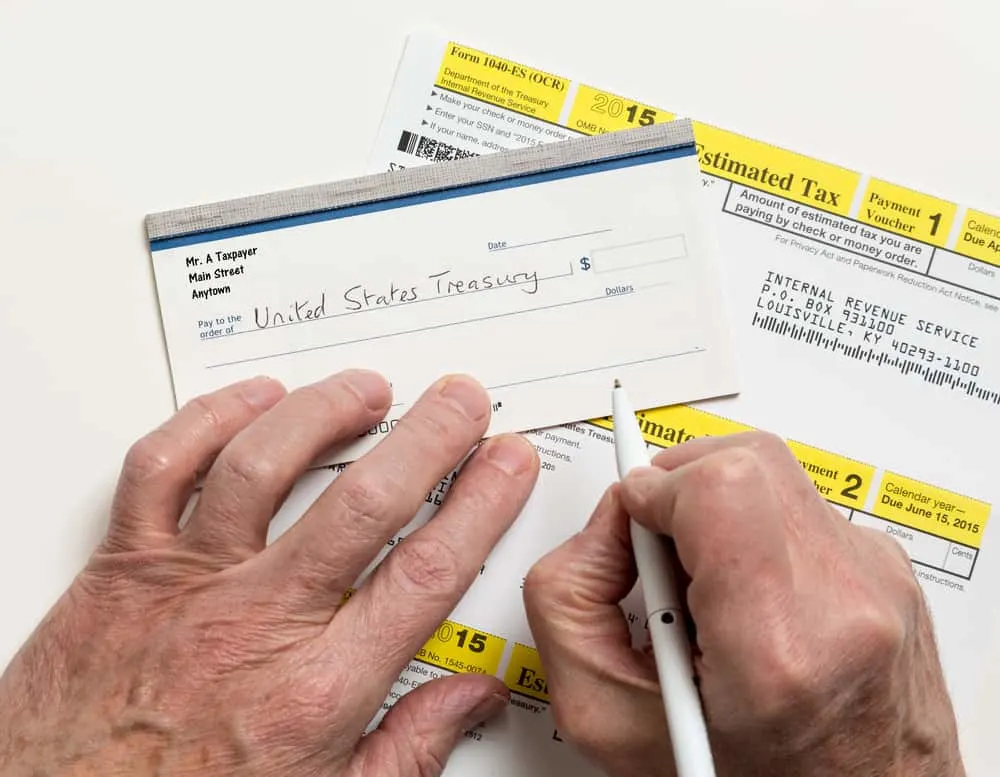It’s a common question for independent contractors for gig delivery companies like Doordash, Grubhub, Postmates and Uber Eats – Do I need to pay in ahead of time?
It’s a question that arises every quarter, and especially comes to mind at the start of the new year with tax day looming.
If you are going to have to pay in on your taxes, yes, you will want to make payments throughout the year.
If you’re reading this before January 15, you need to really think about whether you’ll owe money on tax day.

What are the quarterly taxes for Grubhub, Doordash, Uber Eats Delivery Drivers?
There’s a problem with that caption. There is no such thing as quarterly taxes. That is a phrase that gets tossed around a lot but it creates confusion. Some end up believing that it means that these are taxes in addition to your year end taxes.
What we are talking about are early tax payments. The IRS refers to them as Estimated Tax Payments. Sometimes they are referred to as Quarterly tax payments.
These are payments you need to be making if you are not having money withheld from your earnings and if you expect to owe money at the end of the year.
The IRS has you file taxes at the end of the year, but they want you to pay as you go. They require that the bulk of your taxes be already paid by the end of the year.
This is fairly easy when you work a traditional job with a W-2 and where taxes are withheld. All of your social security and medicare taxes are paid immediately, and depending on how you instruct your employer, money is also set aside on your behalf for your state, local and federal income taxes.
Challenges for self employed individuals
It’s not so easy when you are self employed, like we are as contract delivery drivers for gig companies like Grubhub, Doordash, Postmates and Uber Eats. It’s especially difficult for many because the numbers are not cut and dried like they are with a traditional job.
Taxes on employee wages are easy to calculate, not so much with self employed earnings. You are taxed like a business, on your profits, and there are a lot of variables.
If all you have known in the past is a traditional job with a traditional paycheck with a traditional W-2, you may not be prepared for how taxes work.
The great thing about the employee structure is that your employer is taking tax money out before you ever see a dime. You never really feel that tax money coming out of your pocket because it was never in your pocket in the first place. All you know is you got a refund at the end of the year. The hundreds or thousands that were already paid in on your behalf were never really noticed.
But now that you have to do that for yourself, you really feel it.
And then there is self employment tax. Now understand, this is not really a new or different tax. It’s our version of Social Security (you may know it as FICA) and Medicare.
When you’re new to being self employed, you’re really not ready for that. Yes, you see it on your pay stub but it’s just paid for you. You never have to file forms or anything.
But now, it’s on you to report it and pay it. It’s different than income tax in that it’s charged on every dollar of profit you make.
What do I do now that the 4th Quarter deadline is on us?
Normally I would say, get a tax pro. That might be hard to get lined up this quickly. But seriously, think about getting someone who can help you. You may be able to figure this all out yourself, but if there’s any doubt, someone who knows what they are doing will more than likely save you a lot more than what you pay them. It’s worth it.
But here’s my advice. Run your taxes. Now. Today.
I know, I know, you don’t have all the forms. You probably don’t have any of the forms. That doesn’t matter.
The reality is your taxes that you run right now? It will be wrong. That’s okay.
What you are trying to do right now is get a feel for what your taxes will be. You could be a hundred dollars off. You could be several hundred dollars off. That’s okay. You’re just trying to get an idea.
Do a dry run of your taxes. If it looks like you are going to owe some money, that tells you it might be a good idea to make a payment by the end of the day tomorrow.
And what if you were wrong? What if you thought you would owe and it turns out you didn’t? You’ll get that payment back as a refund.
Doing a dry run on your taxes
I don’t know how you plan on figuring your taxes. How have you done them in the past? Did you use software before? Or did you have it prepared for you?
If you used software programs like Turbo Tax or H&R Block, they probably already sent the new software to you. If nothing else you can go over to a free tax program like Credit Karma.
Don’t worry about getting it all correct. Don’t put huge amounts of time into it. You want to run the basics. You aren’t running it to file, DO NOT FILE taxes yet. You’re just doing a dry run to get a general idea what it’s going to look like.
Getting the information together when you have no forms
If you (and your partner if filing joint) have any W-2 income and haven’t received those forms yet, pull the last paystub of the year. It’ll give you most of what you need.
There are a lot of things you don’t know the exact details of, but you should have a general idea. If you itemize your deductions, that makes it a bit more complicated.
I wouldn’t stress too much about getting all the exact numbers. I wouldn’t even worry too much about if you missed anything. You probably will. And it’s okay. If it’s close enough, that’s close enough.
Okay, but what about your business? What about your delivery income from Grubhub, Postmates, Doordash, Uber Eats or any other independent contractor gigs? What about your expenses?
You may still have a lot of work to do getting the final numbers. Again, this is a dry run, it doesn’t have to be precise yet.
Here’s a short cut for figuring out your business numbers

If you still have a LOT of figuring to do on your self employment expenses, you don’t need to do all that yet for this dry run. Here’s the deal: You have miles, and you have everything else. Unless you have some really unusual circumstances or you don’t deliver with your car, that ‘everything else’ is a pittance compared to your miles.
Remember that this is a dry run and you’re not worried about accuracy, you just want to get in the ball park. Or even in the neighborhood of the ballpark.
So what you’re going to do is just calculate a rough profit. You only need two pieces of information: how much did you bring in, and how many miles did you drive?
If you haven’t been tracking your earnings, go figure it out now. If the app you worked with didn’t give you a yearly total yet, go through the app’s records if they are available.
Doordash doesn’t provide those records, it’s all on you (the earnings tab only goes back a few months). Grubhub doesn’t have a yearly total but they did send out weekly emails with an earnings summary. You’ll just have to add them up.
If you can’t find it in the app, you’ll need to get into your bank records. Don’t forget to check the records for any account you used for any instant cash out or daily pay that you may have taken on a debit card.
Add it all up. That’s your business income.
Now multiply your miles times 67 cents for 2024, 70 cents for 2025. For example 10,000 miles is $6,700.
Subtract that total from your earnings (so in that example if you earned $10,000, subtracting the $6,700 leaves you with $3,300). THAT is your rough profit.
If your mileage expense is greater than your earnings, you know already that you didn’t have any taxable income for your delivery business. You are probably in good shape for your taxes.
However, if you did have a rough profit, then what you do when you run your taxes is just enter that rough profit into the part where you put in self employment income, and don’t worry about entering business expenses. For the purposes of the dry run, you don’t need the detail.
What do you do if your dry run looks like you will owe taxes?
How much will it be? Is it a lot?
Remember, this is not meant to be accurate. It’s a ballpark number. It’s meant to give you an idea of what to expect. This could be off by several dollars. Maybe more than several dollars.
If the idea is that you’ll owe, you really want to see if there’s a way to pay anything in for the last quarter estimated tax.
Now, when all is said and done you may figure out you didn’t need to send anything in, but that’s okay. You’ll get that payment back as part of your refund then.
What if it looks like I’ll owe a lot more than what I can pay in estimated payments?

There’s not much more scary than looking down the barrel of a HUGE tax bill and wondering how you’re going to pay it. Maybe that’s had you resist even thinking about taxes up to now.
It’s just scary.
But here’s the thing: That money isn’t due for 3 months (as of the date of this post anyway). You have time to get that money together.
Think of it this way: that’s 12 weeks. If you average $20 per hour, and work one hour extra per week, that’s $240 you’ve saved. For every thousand dollars you owe, that’s about 4 extra hours you can work a week to start saving up for it. It’s manageable.
Here’s another way to think about it. If THAT doesn’t seem managable, it’s time to do some soul searching. It’s not getting better next year. Maybe this self employment gig isn’t paying what you thought. That’s okay to recognize.
There’s time. But now is the time to start figuring out if you NEED that time.


